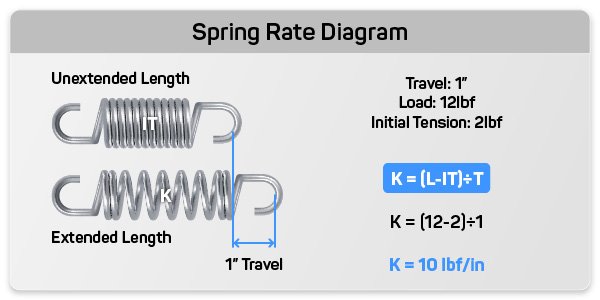







ENTER YOUR DIMENSIONS
Select Your Spring Type
COMPRESSION
EXTENSION
TORSION
Select Your Unit of Measurement
Warning Messages
Table of Content:
Definition: Spring tension, in the context of an extension spring, is a measurement of the force it exerts.
Extension springs come preloaded, meaning they already store force between their coils before extending. This initial tension needs to be considered when calculating the spring's working loads. To accurately determine spring tension, you'll need to factor in both the spring rate and this additional initial tension.
One way to calculate spring tension is by using our spring calculator, Spring Creator 5.0 which can provide values for initial tension, spring rate, and working loads. Alternatively, you can measure spring tension with a simple scale. Initial tension becomes exhausted when the extension spring's coils extend to the point where you can see light in between the coils.
Calculating Spring Rate This diagram illustrates how to calculate your spring's rate using values from your working loads and the initial tension. To determine the rate, subtract the initial tension from the load and then divide the result by the distance traveled from the length inside hooks to the total extended length.

Where:
Use Spring Creator 5.0 For a quick and accurate way to calculate spring tension, spring rate, and other important extension spring parameters, consider using Spring Creator 5.0, a powerful tool for extension spring design and analysis. This software streamlines the process and ensures precise results. By inputting the relevant data, you can easily determine the spring's characteristics and suitability for your application.
Don't hesitate to leverage the benefits of Spring Creator 5.0 for all your spring measurement and design needs.
Created by Alfonso Jaramillo J
President Acxess Spring
Over 40 Years of Experience in Spring Engineering and Manufacturing

Your 3D is being generated, 3D generation Will take approximately 15 seconds. Your 3D Will load automatically on this page.

Your 3D is being generated, 3D generation Will take approximately 15 seconds. Your 3D Will load automatically on this page.
Spring Creator is an Acxess Spring Product, You will be redirected to acxesspring.com for your purchase
Click to open acxesspring.com
